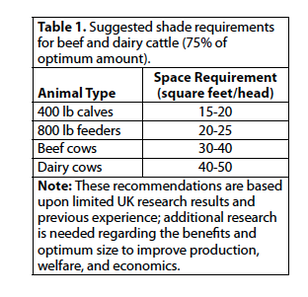|
With hot and humid summer days approaching, it is important to ensure that your cattle have access to shade. Kentucky is known for its hot and humid summers, which puts your cattle at a risk for experiencing heat stress. Here at Eden Shale, we built shade structures for areas where natural shade from trees was not an option. Shade is a must for pasture-based grazing systems. It reduces heat stress, which is detrimental to cattle and causes a decrease in feed intake, weight gains, and fertility. Heat stress is made worse in Kentucky and other humid parts of the eastern United States by the endophytic fungi that infect tall fescue, which is one of the most widely grown pasture grasses in the region. It’s estimated that up to 95% of tall fescue pastures are infected with endophytes. Cattle grazing endophyte infected pastures experience increased body temperatures, largely from their inability to effectively transfer heat from their skin by sweating. Although animals tend to reduce feed intake when they congregate under shade, there are benefits to shade in pasture-based grazing systems. Although the benefits of providing shade to cattle will vary depending on factors (such as breed, coat color, weight, and health), research shows that shade improves weight gain, conception rates, pasture use, and water quality. The nice thing about these shade structures is that they are portable and low-cost to make. We built ours with 2.5 inch pipe and welded it into a frame sturdy enough to withstand cattle. A portable shade structure should be no more than 10x20 feet to be practical. Blueprints for the shade structures can be found by clicking the "Shade Structures Publication" button at the bottom of this post. For the shade cloth on top, you want something that allows for air movement. Use a cloth that reduces light by 80%. If secured tightly to the frame, shade cloth can last about five years before it needs to be replaced. You can also use solid roofing, such as corrugated metal, which is a cost-effective, low-maintenance option. The amount of shade needed depends on the type and age of the cattle. The optimum recommendation is approximately 40-70 square feet/head of shade for mature cows on pasture, but that's difficult to achieve. A practical compromise is to provide 75% of this requirement. For example, a 30 cow beef herd would require 900-1,200 square feet of shade, or five to size portable shades (each 10x20 ft). Place the structures at least 50 feet away from large obstructions (such as buildings) to allow for sufficient airflow. Fencing is not considered an obstruction unless it prevents cattle from accessing shade. The structures should be placed in a north-south orientation to help keep the area underneath dry. Portable shade structures should be moved periodically. If moving the structures is not feasible, place a heavy traffic pad underneath them to reduce the creation of mud under and around the shaded area. Shade placement will affect grazing patterns and forage use, so you should observe animal traffic patterns and adjust shade locations accordingly for best pasture use. For blueprints and more information on shade structures, download the University of Kentucky publication below.
Be sure to attend our Large Hay Feeder & Fenceline Feeders Tour on Tuesday, June 25th at 4pm! |
Archives
June 2024
Categories
All
Welcome |
CONTACT US |
EMAIL SIGN UP |
|
Eden Shale Farm
245 Eden Shale Rd. Office: (859) 278-0899 Owenton, KY 40359 Fax: (859) 260-2060 © 2021 Kentucky Beef Network, LLC.. All rights reserved.
|
Receive our blog updates
|






 RSS Feed
RSS Feed
